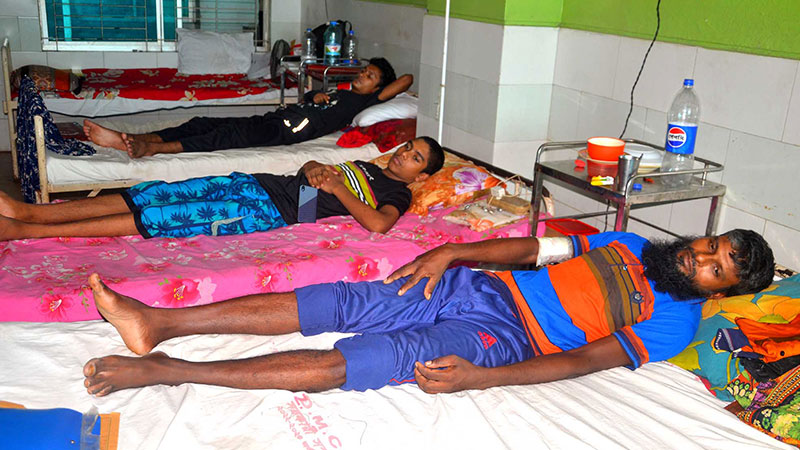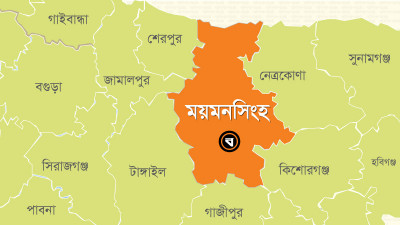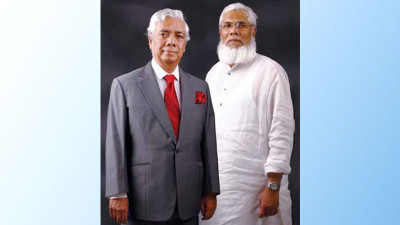 Many of those who were shot during the movement are still receiving treatment at Shaheed Ziaur Rahman Medical College Hospital. Photo: Staff Photographer
Many of those who were shot during the movement are still receiving treatment at Shaheed Ziaur Rahman Medical College Hospital. Photo: Staff Photographer Mohammad
Shamim (38), a resident of Naruli in Bogura, was shot in front of Bogura Sadar
Police Station on August 4, the day before the fall of the Awami League
government. On that day, protesters demanding the resignation of Sheikh Hasina
attempted to enter the city with a procession, prompting police to open fire.
Several people were shot, and they were rushed to Shaheed Ziaur Rahman Medical
College Hospital (SZMCH). While many of the injured have recovered and returned
home, Shamim remains in the hospital.
Shamim’s
legs were hit by multiple bullets. Though he can barely walk with the help of a
cane, his legs sometimes go numb. He still struggles to sleep due to the pain
and gets startled by any loud noise resembling gunfire. However, he remains
hopeful of walking freely in the open air once again.
A
medical team from China has arrived in Bangladesh at the government’s
invitation to provide medical services to those injured during the July-August
movement. The team has already examined the treatment procedures of over 150
patients, expressing their satisfaction, according to Dr. Shah Md. Helal Uddin,
Additional Secretary of the Health Services Division (Planning), during a press
conference held on Thursday (September 26) at the Ministry of Health and Family
Welfare.
According
to sources within the Health Services Division, the Chinese team arrived in
Bangladesh on September 22 and began their work on September 23. In that time,
they have observed 160 patients and reviewed the medical records of 105 of
them.
Dr.
Shah Md. Helal Uddin stated, “Within 24 hours of informing the Chinese
Ambassador, the Chinese government formed a medical team for the injured.
Within 48 hours, they were sent to Bangladesh. It’s truly remarkable. The team
visited five hospitals, offering various treatment suggestions after examining
the patients. They also noted that some patients were in critical condition.”
The
Chinese medical team is primarily an assessment team, Dr. Helal Uddin added.
“They will return to consult with higher authorities and specialists and send
us a comprehensive assessment report. Three patients remain in critical
condition, two of whom are in the ICU, and one has sustained severe eye
injuries. Several others have nerve injuries. Our initial efforts will focus on
ensuring proper treatment within Bangladesh, and we will take steps based on
the recommendations of the Chinese medical assessment team. We are working to
bring Chinese experts to Bangladesh for treatment. If necessary, we will
consider sending patients abroad for advanced care. The Ministry of Health is
committed to ensuring proper treatment for the injured,” he said.
The
Chinese medical team also evaluated whether the treatment for the injured
protesters followed international protocols. They expressed satisfaction with
the treatment provided. The team also reviewed whether hospitals had adequate
resources, such as skilled physicians and medical equipment, noting some
deficiencies in several areas, according to Dr. Helal Uddin.
The
Anti-Discrimination Student Movement launched their protests on July 1,
demanding reforms to the quota system in government jobs. Initially, the
protests were peaceful, but on July 15, when members of Chhatra League and law
enforcement responded aggressively, the movement turned violent. Many lost
their lives, some were permanently disabled, and others lost their eyesight.
Currently, 24 people injured during the July-August movement are still
receiving treatment at SZMCH. Many of them sustained gunshot wounds to
different parts of their bodies. Some, with eye injuries, are still struggling
to see properly. They are counting the days, hoping to return to normal life.
According
to SZMCH hospital sources, seven people were killed during the July-August
uprising in Bogura, and over 400 were injured and admitted to the hospital. The
highest number of admissions occurred on August 4, when the influx of injured
people overwhelmed doctors. Some were discharged after a few days, while others
underwent surgeries. Several critically injured patients were transferred to
Dhaka for advanced treatment. Those still receiving care at SZMCH have gunshot
wounds in their legs, arms, chests, and heads. Some have over a hundred wounds from
rubber bullets or pellets.
Helalur
Rahman (30) from Mallikpur union in Kahaloo Upazila was shot in front of
Dupchanchia Police Station on August 4 at noon. He was being treated at SZMCH.
However, as his condition worsened, he was transferred to Dhaka for advanced
care on September 21.
Bogura correspondent H. Aleem contributed to this report.






